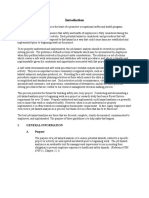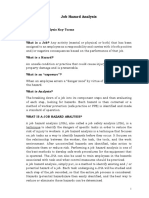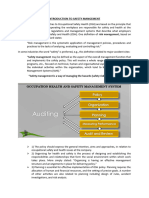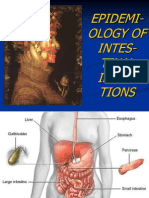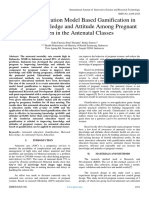100%(1)100% found this document useful (1 vote)
21 viewsNC State JHA Instructions Printable Version
NC State JHA Instructions Printable Version
Uploaded by
Raynus ArhinThis document provides instructions for conducting a Job Hazard Analysis (JHA) to identify and control workplace hazards. It defines key terms like hazards, controls, and exposure. It outlines a 5-step process to perform an effective JHA: 1) Define the scope of work, 2) Break the job into tasks, 3) Identify hazards for each task, 4) Develop control measures for each hazard, 5) Note required training. The goal is to analyze jobs, identify existing and potential hazards, and implement controls to eliminate or reduce risk of injury. Appendices provide examples of common hazards, control measures, and a training presentation to support the JHA process.
Copyright:
© All Rights Reserved
Available Formats
Download as PDF, TXT or read online from Scribd
NC State JHA Instructions Printable Version
NC State JHA Instructions Printable Version
Uploaded by
Raynus Arhin100%(1)100% found this document useful (1 vote)
21 views2 pagesThis document provides instructions for conducting a Job Hazard Analysis (JHA) to identify and control workplace hazards. It defines key terms like hazards, controls, and exposure. It outlines a 5-step process to perform an effective JHA: 1) Define the scope of work, 2) Break the job into tasks, 3) Identify hazards for each task, 4) Develop control measures for each hazard, 5) Note required training. The goal is to analyze jobs, identify existing and potential hazards, and implement controls to eliminate or reduce risk of injury. Appendices provide examples of common hazards, control measures, and a training presentation to support the JHA process.
Copyright
© © All Rights Reserved
Available Formats
PDF, TXT or read online from Scribd
Share this document
Did you find this document useful?
Is this content inappropriate?
This document provides instructions for conducting a Job Hazard Analysis (JHA) to identify and control workplace hazards. It defines key terms like hazards, controls, and exposure. It outlines a 5-step process to perform an effective JHA: 1) Define the scope of work, 2) Break the job into tasks, 3) Identify hazards for each task, 4) Develop control measures for each hazard, 5) Note required training. The goal is to analyze jobs, identify existing and potential hazards, and implement controls to eliminate or reduce risk of injury. Appendices provide examples of common hazards, control measures, and a training presentation to support the JHA process.
Copyright:
© All Rights Reserved
Available Formats
Download as PDF, TXT or read online from Scribd
Download as pdf or txt
100%(1)100% found this document useful (1 vote)
21 views2 pagesNC State JHA Instructions Printable Version
NC State JHA Instructions Printable Version
Uploaded by
Raynus ArhinThis document provides instructions for conducting a Job Hazard Analysis (JHA) to identify and control workplace hazards. It defines key terms like hazards, controls, and exposure. It outlines a 5-step process to perform an effective JHA: 1) Define the scope of work, 2) Break the job into tasks, 3) Identify hazards for each task, 4) Develop control measures for each hazard, 5) Note required training. The goal is to analyze jobs, identify existing and potential hazards, and implement controls to eliminate or reduce risk of injury. Appendices provide examples of common hazards, control measures, and a training presentation to support the JHA process.
Copyright:
© All Rights Reserved
Available Formats
Download as PDF, TXT or read online from Scribd
Download as pdf or txt
You are on page 1of 2
Environmental Health and Safety
Occupational Safety
JSA Instructions
Job Hazard Analysis
1. Purpose
A Job Hazard Analysis (JHA) is an analysis of the hazards and risk associated
which focus on identifying and controlling hazards. Utilizing the JHA will provide
a process for analyzing the work activities that will identify the tools, materials
and equipment needed to develop work methods and procedures for
accomplishing the task. The process will identify existing and potential hazards
and assessing the risk and identify methods to eliminate or protect against the
hazard.
2. Definitions
1. Controls: This is how to eliminate or minimize the hazards. There are three
types of controls
a. Engineering controls eliminate or reduce exposure to a chemical or
physical hazard through the use or substitution of engineered machinery
or equipment. This is the preferred control
b. Administrative controls are changes in work procedures such as written
safety policies, rules, supervision, schedules, and training with the goal of
reducing the duration, frequency, and severity of exposure to hazardous
chemicals or situations.
c. Personal Protective Equipment (PPE) - Personal protective equipment,
commonly referred to as "PPE", is equipment worn to minimize exposure
to hazards that cause serious workplace injuries and illnesses.
2. Exposure – When an employee enters a “danger zone” by virtue of their
proximity to the hazard
3. Hazard - An unsafe condition or practice that could cause injury, illness, or
property damage and is preventable. Examples of hazards include: working at
heights, slippery surfaces, exposed moving machinery parts, fire, explosion,
noise, electricity, toxic emission, corrosive chemicals, low oxygen, repetitive
tasks, heavy lifting, infectious Bloodborne pathogens, assault
4. Job Hazard Analysis- A process that focus on job task as a way to identify
hazards before they result in injury. It focuses on the relationship between the
worker, the task, the tools and equipment, and the environment and identifies
control to reduce or eliminate the hazard. .
5. Task - Any activity (mental or physical or both) that has been assigned to an
employee as a responsibility and carries with it both positive and/or negative
consequences based on the performance of that job.
3. Steps To An Effective JHA (See Appendix A Job Hazard Analysis Form)
1. Define the scope or the work to be analyzed and watch the work being done.
a. Involve the employee performing the work
June 20, 2018 Page 1 of 2
Environmental Health and Safety
Occupational Safety
JSA Instructions
2. Break the job down into small tasks or steps.
a. Each task or step should be written on the worksheet one by one. Avoid
creating steps that are too small, as the analysis may become too long
and cumbersome.
b. Watch the employee performing the work
c. Ask other employees who have performed the task what are the steps to
perform the work
3. In the Hazard column identify and write down the hazards associated with each
task. See Appendix B Common Hazards and Descriptions for types of
hazards. Consider every possible thing that could go wrong. Questions you can
ask are:
a. What could go wrong?
b. What could cause things to go wrong?
c. What other factors could contribute to an incident or injury to the worker?
d. How could equipment be damaged
4. Next the Control Measure should be developed (See Appendix C Hazard
Control Measures). Write down all the possible controls for each of the hazards
identified in each of the task. There may be several controls that can be used for
each hazard. This may include procedures, practices, and personal protective
equipment (PPE)
a. Controls include and should be implemented in the following sequence:
i. Engineering – eliminate of the hazard or reduced exposure to the
hazard
ii. Administrative – Reducing the exposure by changing conditions or
the way that the work is done
iii. Personal Protective Equipment – When exposure to hazards
cannot be engineered completely out and administrative control
cannot provide sufficient additional protection. PPE is the last line
of defense.
5. After finishing listing the tasks, hazards and controls, write down any training that
is required to address the hazards, operate equipment or needed to perform the
task.
6. Write down the types of Personal Protective (PPE) that may have to be used to
control the hazards.
7. Review JHA with employees performing the work.
8. The JHA can always be reviewed and upgraded when new information is needed
to be added.
5. Training
1. See Appendix D JHA Training PowerPoint Presentation
2. Face-To-Face training can be obtained by contacting EHS
Phone: 919.515.7915
Email: env-health-occ-safety@ncsu.edu
June 20, 2018 Page 2 of 2
You might also like
- 5.case Presentation On Puerperial SepsisDocument38 pages5.case Presentation On Puerperial SepsisAngela Jolhnem Langhu92% (25)
- Nebosh IGC Element 6 Principles of Control (Notes)Document6 pagesNebosh IGC Element 6 Principles of Control (Notes)kkalvi100% (26)
- Mother and Baby Friendly Hospital Initiative - Session 15 MBFHDocument27 pagesMother and Baby Friendly Hospital Initiative - Session 15 MBFHthirdielacorte67% (3)
- Implementing Guidelines For The Establishment of HPN and DM ClubDocument15 pagesImplementing Guidelines For The Establishment of HPN and DM ClubChristian Felix Ignacio100% (2)
- Hand Out Maintenance Course For EngineersDocument109 pagesHand Out Maintenance Course For EngineersGauravNo ratings yet
- HPM 819Document7 pagesHPM 819hksinghsengarNo ratings yet
- Job Hazard AnalysisDocument4 pagesJob Hazard AnalysisJoanna MarieNo ratings yet
- 1.8 Risk Assessment PlanDocument4 pages1.8 Risk Assessment PlanShams TabrezNo ratings yet
- Job Safety Analysis in Material Handling: S.M.S.N K, M.GDocument3 pagesJob Safety Analysis in Material Handling: S.M.S.N K, M.Gashok KumarNo ratings yet
- TLE Household Services 7and8 Q1 LAS 3Document14 pagesTLE Household Services 7and8 Q1 LAS 3Laiza GarraNo ratings yet
- OccupationDocument16 pagesOccupationsarooneymorrisNo ratings yet
- Worksite Hazard Analysis: Presented By: Thomas Dean Georgia TechDocument113 pagesWorksite Hazard Analysis: Presented By: Thomas Dean Georgia TechsahibjotNo ratings yet
- TVL-CapsLET - ANI - Week2b (OHS) - Palis, MaryGayDocument15 pagesTVL-CapsLET - ANI - Week2b (OHS) - Palis, MaryGayArthur ManaloNo ratings yet
- Tle He CG7&8 W7 8Document4 pagesTle He CG7&8 W7 8Jonalyn F. LegaspiNo ratings yet
- Duke University - Facilities Management Department: Ergonomics ProgramDocument4 pagesDuke University - Facilities Management Department: Ergonomics ProgramEdgard Bruno Soto LuqueNo ratings yet
- Job Hazard Analysis ProcessDocument25 pagesJob Hazard Analysis ProcessPavithraNo ratings yet
- MME30001 Minor Activity OHS With Suggested Answers PDFDocument5 pagesMME30001 Minor Activity OHS With Suggested Answers PDFMosesNo ratings yet
- Sweet ReportDocument8 pagesSweet Reportmaila suelaNo ratings yet
- CAREGIVING-7 Q3 Mod5 USLeM-RTPDocument10 pagesCAREGIVING-7 Q3 Mod5 USLeM-RTPKathleen LlanesNo ratings yet
- Hazard Identification, Evaluation and ControlDocument12 pagesHazard Identification, Evaluation and ControlJune Añasco GuzonNo ratings yet
- Basic-Hazard-Identification-&-Risk-Control-Dec 2014Document7 pagesBasic-Hazard-Identification-&-Risk-Control-Dec 2014Md Mahadi Hasan RemalNo ratings yet
- Job Safety Analysis by GautamDocument7 pagesJob Safety Analysis by Gautamgauti0102No ratings yet
- Hazard AnalysisDocument18 pagesHazard AnalysisazozinlcNo ratings yet
- Prevention and Hazard ControlDocument21 pagesPrevention and Hazard ControlKladees WorldNo ratings yet
- TLE-ICT 10 ModuleDocument5 pagesTLE-ICT 10 ModuleClaire CayangcangNo ratings yet
- Job Safety Analysis Fact SheetDocument3 pagesJob Safety Analysis Fact Sheetclvsh1985No ratings yet
- Laboratory Risk Assessment FormDocument8 pagesLaboratory Risk Assessment FormReni Swara Mahardika50% (2)
- SOP DevelopmentDocument3 pagesSOP DevelopmentMithileshNo ratings yet
- Unit 2Document48 pagesUnit 2Mithul SNo ratings yet
- Oil Gas Offshore Safety Case (Risk Assessment) : Pbt750@mun - CaDocument43 pagesOil Gas Offshore Safety Case (Risk Assessment) : Pbt750@mun - CaUlviyye ElesgerovaNo ratings yet
- Oil Gas Offshore Safety Case (Risk Assessment) : Pbt750@mun - CaDocument43 pagesOil Gas Offshore Safety Case (Risk Assessment) : Pbt750@mun - CaUlviyye ElesgerovaNo ratings yet
- Job Safety AnalysisDocument4 pagesJob Safety AnalysisTrebor SantosNo ratings yet
- Hazard IdentificationDocument3 pagesHazard Identificationibrahim.dahadjNo ratings yet
- Oil Gas Offshore Safety Case (Risk Assessment) : August 2016Document44 pagesOil Gas Offshore Safety Case (Risk Assessment) : August 2016Andi SuntoroNo ratings yet
- 7 10 General IndustrialDocument6 pages7 10 General IndustrialFazle Riaz KhanNo ratings yet
- Safety Management - Hazard Prevention and ControlDocument1 pageSafety Management - Hazard Prevention and ControlAjmal AjuNo ratings yet
- Css For Grade 7&8 - FQL3 - BC4 - 3. Control Hazards and Risk - LMS - 2021 - 2022Document10 pagesCss For Grade 7&8 - FQL3 - BC4 - 3. Control Hazards and Risk - LMS - 2021 - 2022Nemino Catulay RickyNo ratings yet
- Chapter 5Document13 pagesChapter 5test 2No ratings yet
- Quarter 2: Week 15 Lo 3. Handle Materials and Equipment Tle-Afac9Hc-Iia-E-3Document8 pagesQuarter 2: Week 15 Lo 3. Handle Materials and Equipment Tle-Afac9Hc-Iia-E-3Romeo Jr Vicente RamirezNo ratings yet
- Job Hazard Analysis-Job Safety AnalysisDocument4 pagesJob Hazard Analysis-Job Safety AnalysisImran Alam100% (1)
- A Study of Solid Waste ManagementDocument12 pagesA Study of Solid Waste Managementpravinsulakhe74No ratings yet
- JHA Development ProcessDocument9 pagesJHA Development Processahmadmakky121No ratings yet
- Job Hazard AnalysisDocument19 pagesJob Hazard AnalysisCharlyn FloresNo ratings yet
- Safety Management: An IntroductionDocument3 pagesSafety Management: An IntroductionNailesh MahetaNo ratings yet
- Learning Guide For Lay, Mark and Cut Complicated FabricsDocument10 pagesLearning Guide For Lay, Mark and Cut Complicated FabricsBrukti firdeNo ratings yet
- Job Safety Analysis: Accident Severity: Any Incident ThatDocument4 pagesJob Safety Analysis: Accident Severity: Any Incident ThatFiet GhazaliNo ratings yet
- Safety 6Document11 pagesSafety 6AjejejeNo ratings yet
- Module For Electrical g7 Module 10 Week 9 PDFDocument11 pagesModule For Electrical g7 Module 10 Week 9 PDFAnnalyn dela Cruz-SantosNo ratings yet
- OHSA SafetyDocument2 pagesOHSA SafetyKyrlle LiwanagNo ratings yet
- Final Test of System Safety - Julian Hanggara AdigunaDocument6 pagesFinal Test of System Safety - Julian Hanggara AdigunaThe Minh NguyenNo ratings yet
- A0T8Y5 - BRC EH-S Handbook - Part 5Document69 pagesA0T8Y5 - BRC EH-S Handbook - Part 5teguh.setionoNo ratings yet
- Unit 7 - VideoClipRef - 2021Document6 pagesUnit 7 - VideoClipRef - 2021Nella NellaNo ratings yet
- Safe Operating Procedure (SOP) Development: PurposeDocument3 pagesSafe Operating Procedure (SOP) Development: Purposesaad100% (1)
- HWM NotesDocument187 pagesHWM NotesroshanNo ratings yet
- Hazard Identification ModuleDocument7 pagesHazard Identification ModuleEmmanuel Milla-gracia GarilNo ratings yet
- Chapter 07Document43 pagesChapter 07jayanthNo ratings yet
- Basic Steps For Developing A Job Safety AnalysisDocument1 pageBasic Steps For Developing A Job Safety AnalysisNicoleAbdonNo ratings yet
- Health and Safety-Hazard Identification and Elimination and Risk Assessment andDocument1 pageHealth and Safety-Hazard Identification and Elimination and Risk Assessment andsandro leonidaNo ratings yet
- Job Safety Analysis (JSA) Training ModuleDocument14 pagesJob Safety Analysis (JSA) Training Modulejuan carlos huallpa espinozaNo ratings yet
- M.E-ISE-2022-24-SM-Introduction To Safety Management-Folder No.1Document7 pagesM.E-ISE-2022-24-SM-Introduction To Safety Management-Folder No.1Veeramuthu SundararajuNo ratings yet
- An Instructional Aid For Occupational Safety and Health in Mechanical Engineering Design: Enter asset subtitleFrom EverandAn Instructional Aid For Occupational Safety and Health in Mechanical Engineering Design: Enter asset subtitleNo ratings yet
- The Real Product Safety Guide: Reducing the Risk of Product Safety Alerts and RecallsFrom EverandThe Real Product Safety Guide: Reducing the Risk of Product Safety Alerts and RecallsNo ratings yet
- Tests of Retarding Admixtures For ConcreteDocument32 pagesTests of Retarding Admixtures For ConcreteRaynus ArhinNo ratings yet
- Working Around Heavy Equipment: TBT NoDocument1 pageWorking Around Heavy Equipment: TBT NoRaynus ArhinNo ratings yet
- Legislation and Regulatory Framework For HseDocument19 pagesLegislation and Regulatory Framework For HseRaynus ArhinNo ratings yet
- Fire Prevention and Protection On Oil Well & Rig: Fire Is The Rapid Oxidation of A Material in The ExothermicDocument38 pagesFire Prevention and Protection On Oil Well & Rig: Fire Is The Rapid Oxidation of A Material in The ExothermicRaynus ArhinNo ratings yet
- Report On Near-Miss or Unsafe Act / Condition: Safety - Hazard and Environmental ManualDocument1 pageReport On Near-Miss or Unsafe Act / Condition: Safety - Hazard and Environmental ManualRaynus ArhinNo ratings yet
- Manifest PDFDocument1 pageManifest PDFRaynus ArhinNo ratings yet
- Wheelers Lubricants RangeDocument24 pagesWheelers Lubricants RangeRaynus ArhinNo ratings yet
- Report of Unsafe Condition or HazardDocument1 pageReport of Unsafe Condition or HazardRaynus ArhinNo ratings yet
- Method Statement For Earthworks - Ghana GasDocument7 pagesMethod Statement For Earthworks - Ghana GasRaynus ArhinNo ratings yet
- Venom Catalogue 1Document32 pagesVenom Catalogue 1Raynus ArhinNo ratings yet
- Milestone Sign-Off: Client Name: Drill Masters Africa Limited Milestone: Finance TestingDocument5 pagesMilestone Sign-Off: Client Name: Drill Masters Africa Limited Milestone: Finance TestingRaynus ArhinNo ratings yet
- Marriage and Family Ministries Resources: Updated June 2, 2018Document57 pagesMarriage and Family Ministries Resources: Updated June 2, 2018Raynus Arhin100% (1)
- OHS Induction On Site PDFDocument1 pageOHS Induction On Site PDFRaynus ArhinNo ratings yet
- Print Name Signature DateDocument1 pagePrint Name Signature DateRaynus ArhinNo ratings yet
- Cathodic Protection Specification - Takoradi Oil Terminal 27.02.2018 rv1 PDFDocument12 pagesCathodic Protection Specification - Takoradi Oil Terminal 27.02.2018 rv1 PDFRaynus Arhin100% (1)
- Items Quantity Unit Price ( ) Total Cost ( ) : Material For Painting ProjectsDocument2 pagesItems Quantity Unit Price ( ) Total Cost ( ) : Material For Painting ProjectsRaynus ArhinNo ratings yet
- CHNC StandardsDocument44 pagesCHNC StandardshamdanaNo ratings yet
- Nutritional Treatment of CoronavirusDocument9 pagesNutritional Treatment of CoronavirusVlado GaricNo ratings yet
- Assignment Title: TC1 Response To A Live Employer BriefDocument16 pagesAssignment Title: TC1 Response To A Live Employer Briefsyeda maryemNo ratings yet
- Mousavi 2018Document6 pagesMousavi 2018Alexandra MateiNo ratings yet
- Describing The Population Experiencing Covid-19 Vaccine Breakthrough Following Second Vaccination in England: A Cohort Study From OpensafelyDocument14 pagesDescribing The Population Experiencing Covid-19 Vaccine Breakthrough Following Second Vaccination in England: A Cohort Study From OpensafelyDr Meenakshi ParwaniNo ratings yet
- Worksheet#2-Maintaining Asepsis: Medical Asepsis Includes All Practices Intended To Confine A SpecificDocument4 pagesWorksheet#2-Maintaining Asepsis: Medical Asepsis Includes All Practices Intended To Confine A SpecificCj MayoyoNo ratings yet
- Performance Evaluation of Waste Water Treatment PlantDocument13 pagesPerformance Evaluation of Waste Water Treatment PlantLaliethaNo ratings yet
- Water Testing Lab Laws Lecture NotesDocument24 pagesWater Testing Lab Laws Lecture NotesJhaztiz EstremosNo ratings yet
- CertificateDocument1 pageCertificateGsusNo ratings yet
- DLL - Mapeh-Health 6 - Q3 - W2Document3 pagesDLL - Mapeh-Health 6 - Q3 - W2johnNo ratings yet
- WWSC 2021/22 BudgetDocument46 pagesWWSC 2021/22 BudgetHorsham TimesNo ratings yet
- Dialogue With Pregnant Women Midwife "Motherhood Pregnancy"Document4 pagesDialogue With Pregnant Women Midwife "Motherhood Pregnancy"Mjhd Msthf80% (5)
- Poverty - Environment IndicatorsDocument42 pagesPoverty - Environment IndicatorsdmercesNo ratings yet
- FIGO MifeMiso Chart 11 2023 FINALDocument1 pageFIGO MifeMiso Chart 11 2023 FINALmohammedyosif76No ratings yet
- HEALTH - Q3 PPT-MAPEH10 - Lesson 3 (Issues in The Implementation of Global Health Initiatives)Document18 pagesHEALTH - Q3 PPT-MAPEH10 - Lesson 3 (Issues in The Implementation of Global Health Initiatives)Lemuel Español Camus100% (3)
- Safesite Safety Cert Decision TreeDocument1 pageSafesite Safety Cert Decision Treejson_gabionNo ratings yet
- Format Pencatatan TGL 10-1-2022 Akun PuskesmasDocument11 pagesFormat Pencatatan TGL 10-1-2022 Akun PuskesmassoebirinNo ratings yet
- Viernes 3 - 2° Dosis SputnikDocument48 pagesViernes 3 - 2° Dosis SputnikSilvio GuanucoNo ratings yet
- Lesson 4 - Diseases Sickness Resulting From Exposure To Decaying MaterialsDocument45 pagesLesson 4 - Diseases Sickness Resulting From Exposure To Decaying MaterialsRhetoric Drigz77% (13)
- CHN Quizlet 2Document21 pagesCHN Quizlet 2Arianna Melanie P. DeGuzmanNo ratings yet
- 3011-Article Text-11322-2-10-20221109Document12 pages3011-Article Text-11322-2-10-20221109HidayahNo ratings yet
- Occupational Safety and Health (OSH)Document28 pagesOccupational Safety and Health (OSH)Janissaries NivercaNo ratings yet
- Lecture 3 Epidemiology of Intestinal InfectionsDocument46 pagesLecture 3 Epidemiology of Intestinal InfectionsAli Baker AlgelaneNo ratings yet
- Girl Scouts of The Philippines PermitDocument1 pageGirl Scouts of The Philippines Permitbrave29heartNo ratings yet
- Antenatal Education Model Based Gamification in Terms of Knowledge and Attitude Among Pregnant Women in The Antenatal ClassesDocument4 pagesAntenatal Education Model Based Gamification in Terms of Knowledge and Attitude Among Pregnant Women in The Antenatal ClassesInternational Journal of Innovative Science and Research TechnologyNo ratings yet
- 2nd Summative Test in MAPEH 6 HealthDocument3 pages2nd Summative Test in MAPEH 6 HealthArvin Joseph PunoNo ratings yet
- 1362256258.5314trichomonas VaginalisDocument17 pages1362256258.5314trichomonas Vaginalisricky hutagalungNo ratings yet









































